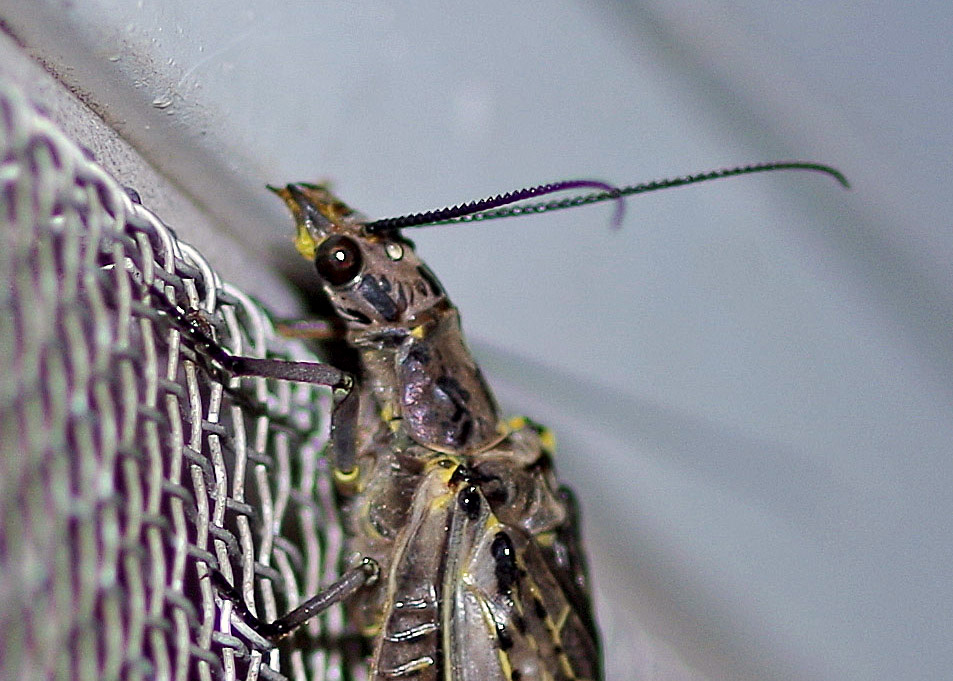
Fishfly Again
Salutations, BugFans,
After a long cool run-up, we’ve had some July weather at the end of May, which will warm the soil and water and may result in everything popping up at once (the BugLady certainly hopes so, because she traditionally takes off the month of June and dedicates it to wandering the trails in search of insects). Anyway, it’s time to start looking for these fabulous fishflies – leave the porch light on. This is a rerun from 2014, with a little polishing and a few new pictures thrown in.
With apologies to the possum that holes up behind the bird food barrels each winter, the fishfly is the favorite of all the critters that visit the BugLady’s front porch (Mom really does like you best).
The first thing you notice when you Google “Fishfly” is that there are lots of hits for mayflies. Mayflies (aka “lake flies”) (order Ephemerata) are a different beast altogether, one that gets our attention when they emerge (any day now) in uncountable numbers for a brief but dramatic flight period/orgy, causing river and lake-side communities to mobilize municipal snowplows to clear the streets and bridges of dead and dying mayflies. Both the aquatic naiads and the aerial adult mayflies are wholesome fish food; fish grab them in the water column as they float to the surface and from below as they rest on the surface after emerging (a fact that has not escaped the notice of fly-tiers).
The star of today’s BOTW is the other fishfly.
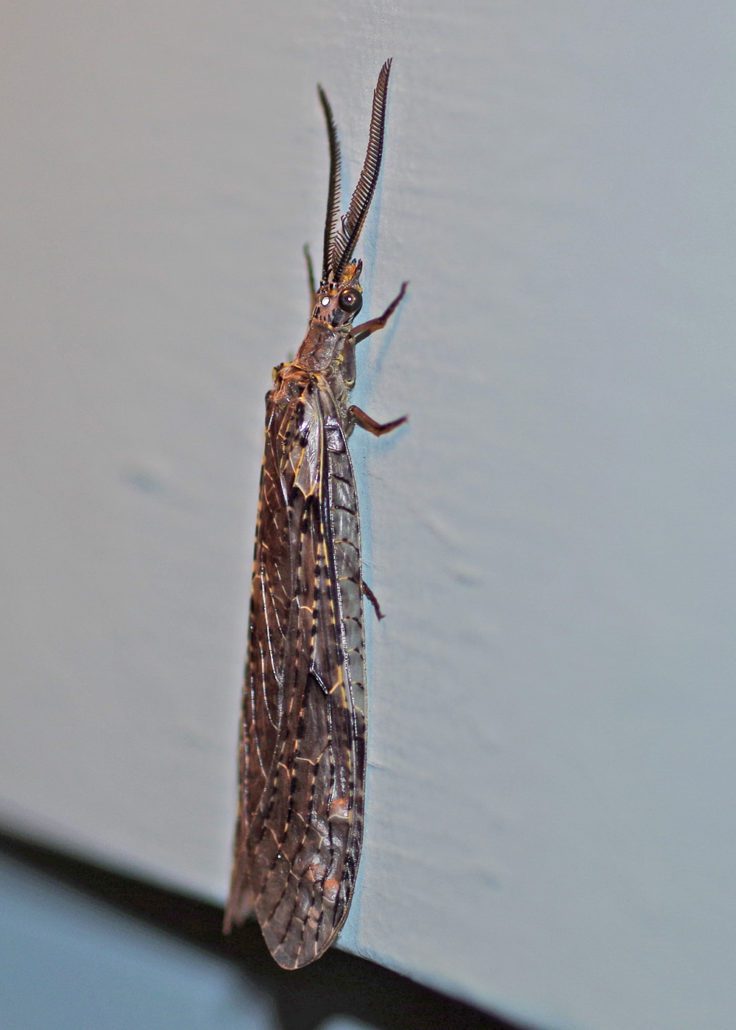
Fishflies were formerly placed in a suborder of the order Neuroptera (nerve wing) along with a bunch of truly odd-looking insects, but fishflies, alderflies and Dobsonflies are now elevated to their own order, Megaloptera (“large/great wing”). Whatever they’re called, they are a primitive bunch, having appeared on the scene more than 259 million years ago. Fishflies are in the family Corydalidae. The BugLady thinks her pictures are mostly of spring fishflies (Chauliodes rastricornis). Chauliodes means “remarkable tooth,” a reference to the larva’s mouthparts, and rasticornus means “rake-horned.”
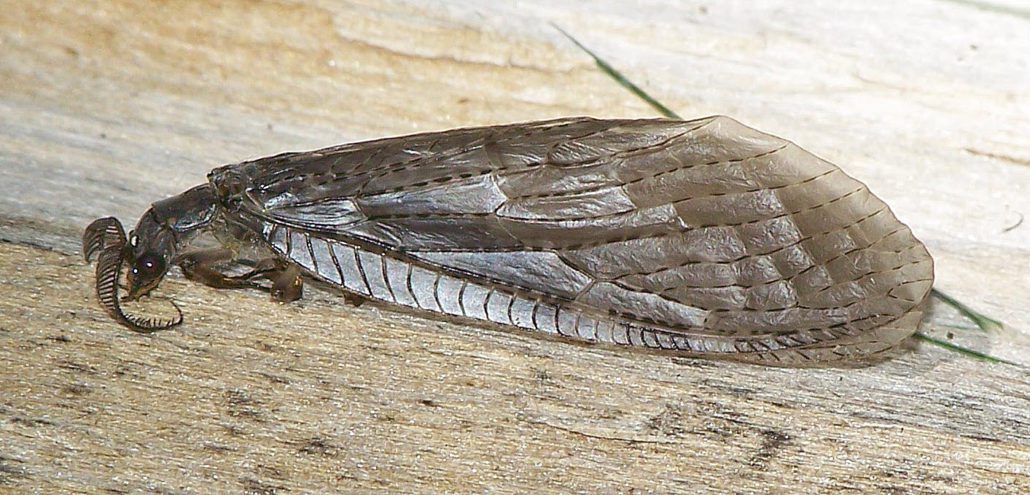
Fishflies can be found throughout much of eastern North America. Adults are generally found near the water that their aquatic larvae require (which is why the landlocked BugLady is always surprised to find them on her porch). Various species of Fishflies may live in streams and rivers or in still ponds; some, reported from ephemeral ponds or streams, can survive a short dry spell if well-buried in wet mud. They have also (uncommonly) been found in tree holes and in the pitchers of Purple pitcher plants.
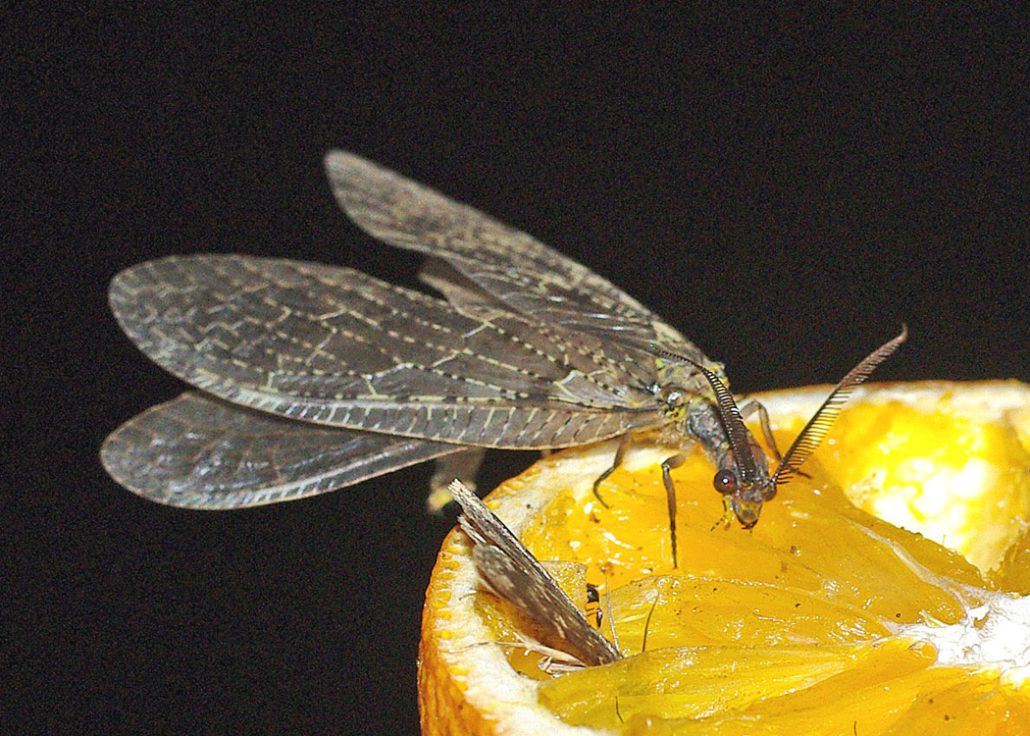
Megalopterans tend to be awkward, soft-bodied, nocturnal fliers. They might possibly be mistaken for a dragonfly in flight, but never at rest. Male Fishflies lack the impressive, pincer-like mandibles of their fierce-looking, five-inch-long Dobsonfly cousins https://bugguide.net/node/view/1802299/bgimage, although at two inches in length, Fishflies are no slouch. Male Fishflies have feathery (pectinate) antennae (females of some species signal their whereabouts with pheromones for him to sense and follow), and the females’ serrate antennae have short, comb-like teeth along one side.
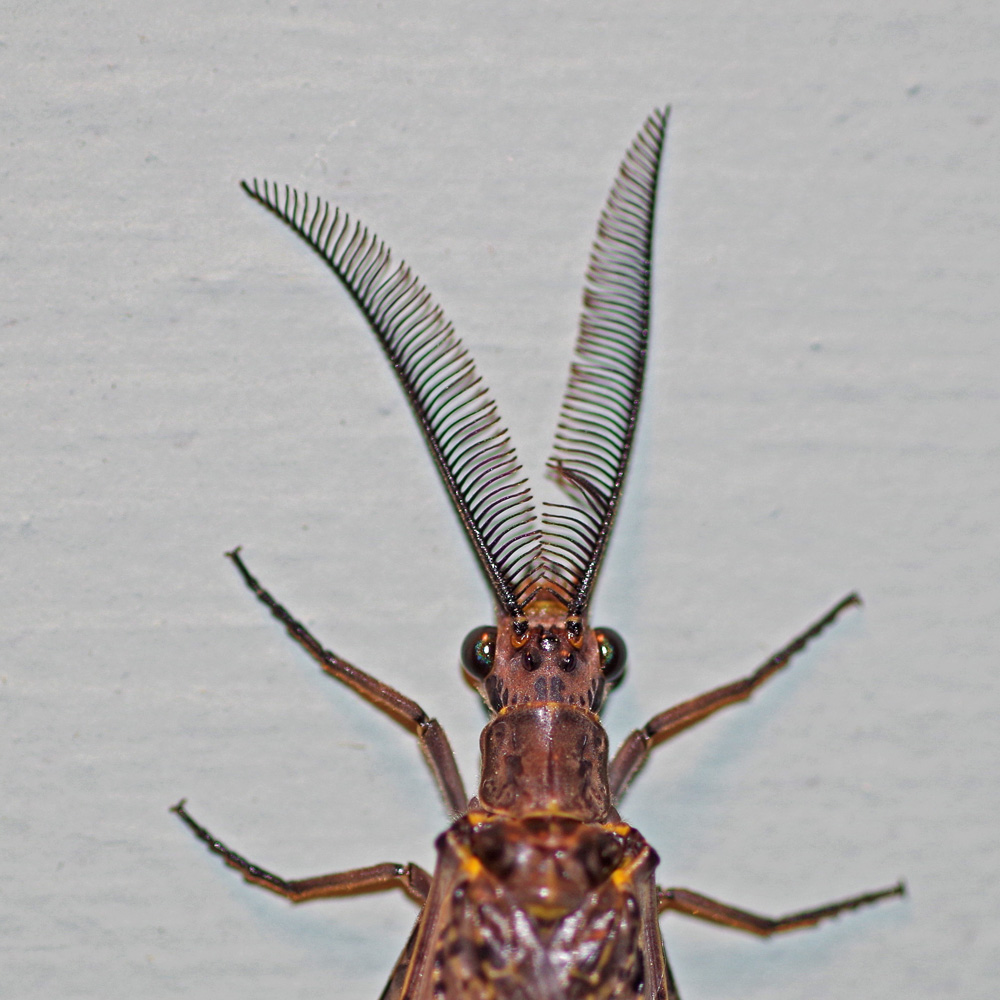
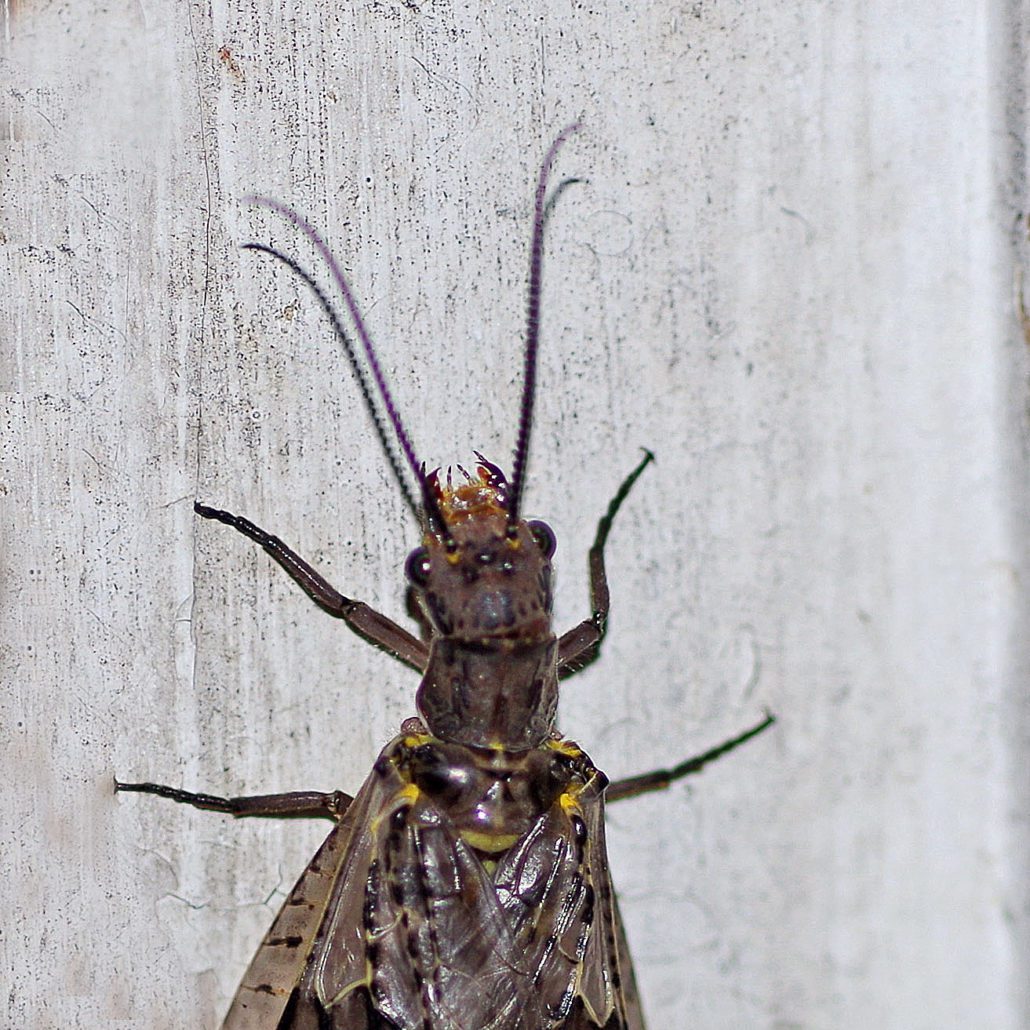
The larvae of both dobsonflies and fishflies are called hellgrammites, and are, famously, sold to fisher-people as bait (the BugLady always pictures the hellgrammite swimming over and grabbing the fish in its “teeth”). Fishflies practice Complete Metamorphosis, hatching from eggs, living as larvae, resting and changing as pupae, and emerging as adults. Like many of the insects that develop this way, their appearance, habitat and diet changes radically in their different life stages.
Eggs (up to 3,000 of them) are laid nocturnally above or near the water – glued together in damp spots like semi-submerged rocks or on twigs and on the undersides of leaves directly above a pond or stream. When the young hatch (nocturnally) they drop/crawl into the water. Fishfly larvae are creatures of the “benthos,” the bottom debris of a pond or river; there they live in the muck or under logs, etc.
The writers who describe them as “worm-like” must live on a very different landscape than the BugLady does. Hellgrammites https://bugguide.net/node/view/49772/bgimage are thick and somewhat flattened, dark brown and shiny, with an impressive head at one end, six legs in the middle, and seven or eight finger-like filaments along each side of the abdomen. The filaments are gills, one of the Fishflies’ breathing strategies.
On land (on their post-hatching trek to water or their pre-pupal hike away from it), they breathe through spiracles (little holes), like terrestrial insects (of course, they don’t open their spiracles underwater). When submerged, they can absorb, through their soft skin, oxygen that is present in the water, but they also breathe through those external gill filaments when oxygen is low. In addition, species that live in still waters have two, long, contractile respiratory tubes at their nether end; with the tips of the tubes poked up above the water surface, they can take in oxygen from our atmosphere. Fishfly larvae don’t move fast, but their bite can be memorable.
Hellgrammites are primarily carnivores, using their chewing mouthparts on minnows, tadpoles, and soft-bodied aquatic insects like mayflies, caddisflies and fly larvae. Some sources list them as scavengers, omnivores and detritivores (animals that feed on detritus – decomposing plant and animal matter).
The New York (State) Entomologist’s “Report of the State Entomologist on Injurious and Other Insects of the State of New York, Vol. 8” (1893) cites observations of the larvae by a Mr. Weed, “Their ordinary mode of locomotion is by crawling along weeds and the debris of various kinds that gathers at the bottoms of ponds, but when alarmed they can swim rapidly by suddenly doubling the body up, bringing the head in contact with the abdomen, by which they are propelled some distance through the water………When handled, the Chaiuloides larvae occasionally eject from the mouth a considerable quantity of a blackish fluid, reminding one of a similar habit of certain locusts (Acrididae). These larvae have also a peculiar habit of walking on the surface of the water, body downward. They can move along in this manner quite rapidly.” Despite their inclusion in that worthy publication, they are not considered pests.
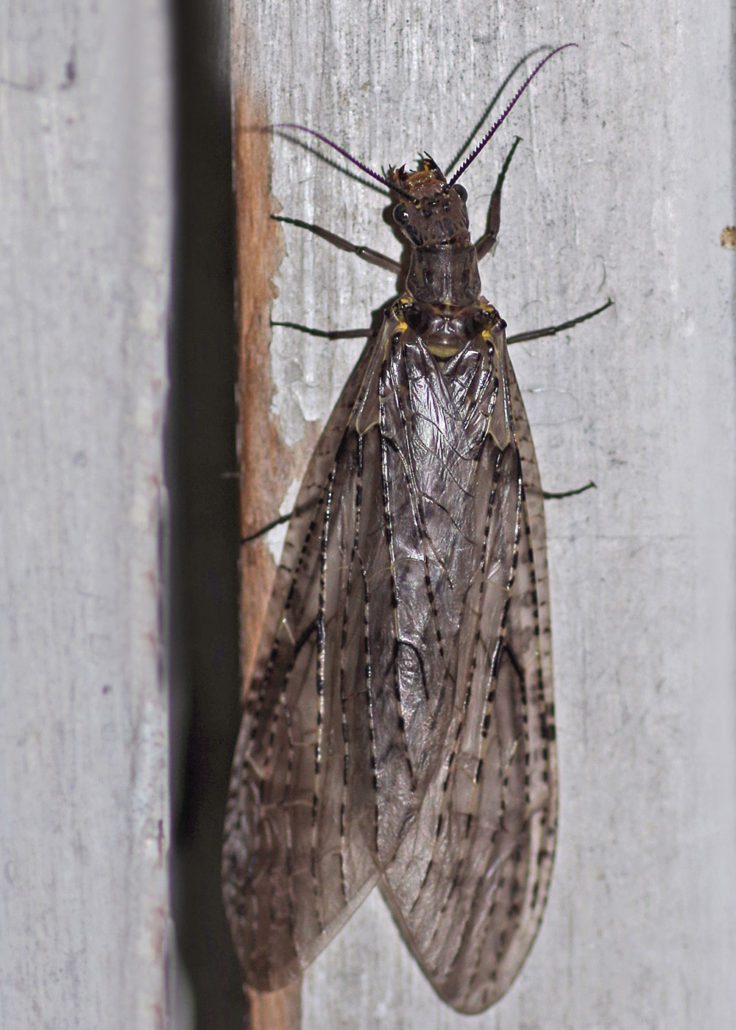
When, after one to three years (larvae in warmer climes mature more quickly), the hellgrammites are ready to pupate, they do it in synchrony with others in their age class. Within a few days, the whole cohort abandons the water, in a sometimes-dramatic migration, to pupate on land. They pupate underground or in rotting wood in spaces/cells that they excavate. Fishfly pupae https://bugguide.net/node/view/192335/bgimage resemble the adults they will become (here’s a nice series of life stages https://bugguide.net/node/view/51193/bgimage), and for pupae, can be pretty active, moving around when disturbed. In his excellent A Guide to Common Freshwater Invertebrates of North America, J. Reese Voshell, Jr. notes that vibrations caused by thunder storms may stimulate the exodus of mature hellgrammites that are ready to pupate!
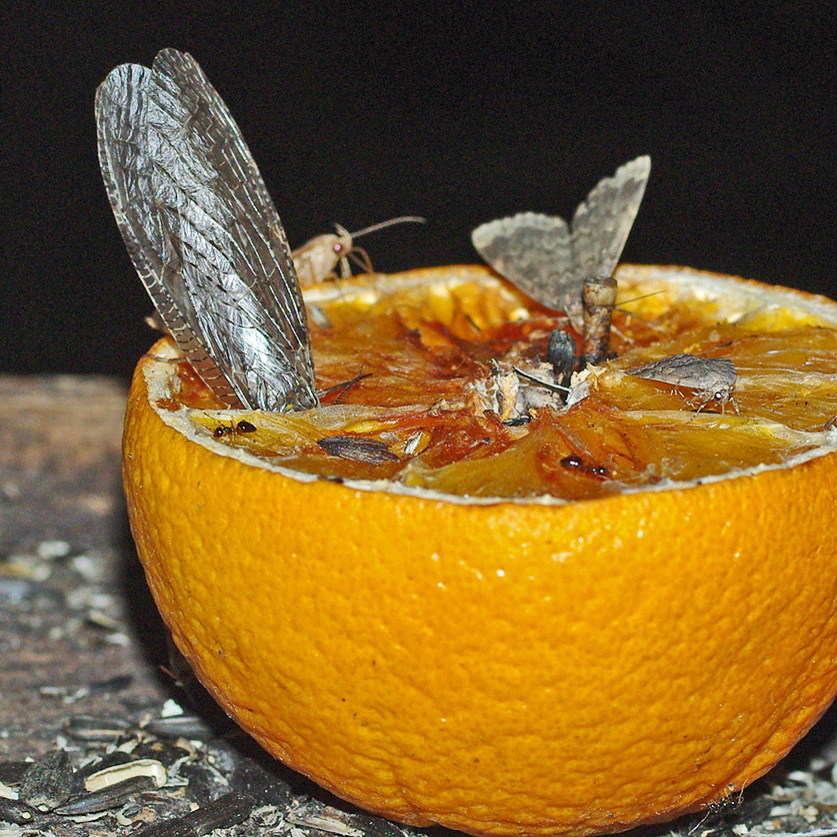
The short-lived adults gather rosebuds while they may. Accounts say that adults are around for a week or so and do not feed; or that males do not feed, or that they sometimes come in to sugar bait in moth traps. Or, apparently, to the oranges the BugLady puts out for birds.
BugFans who are practicing for the next big spelling bee should remember that in entomological usage, if you are spelling a true fly (horse, deer, flower, cluster, blue-bottle, etc.), the words are separate – robber fly, hover fly. The other “flies” –butter, dragon, damsel, May, scorpion, fire, caddis, stone, saw, etc. – are spelled as one word.
So – for the next four weeks, BOTW will be “Closed for June,” but the BugLady will send a timely and tasteful rerun or news item.
Go outside – look for Bugs!
Kate Redmond, The BugLady
Bug of the Week archives:
http://uwm.edu/field-station/category/bug-of-the-week/
